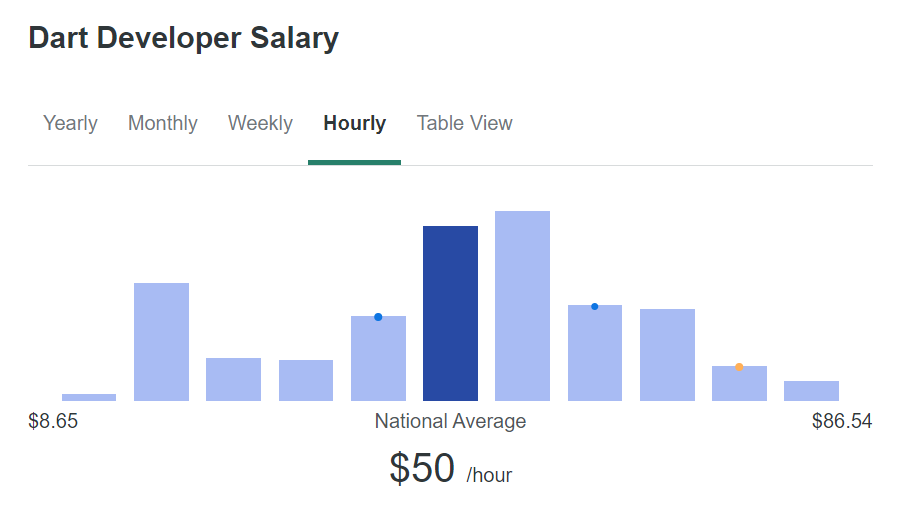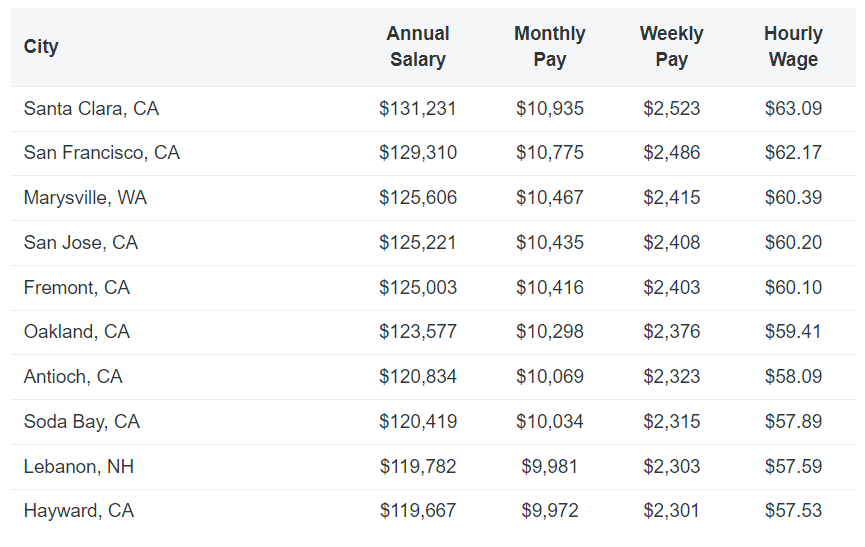How Much Do Dart Developers Make Per Hour?
In the United States, the average hourly pay for a Dart Developer stands at $50.40. Most Dart Developers see their wages fall between $38.22, representing the 25th percentile, and $61.06, representing the 75th percentile.
Table of Contents
This guide offers a closer look at the hourly rates for Dart developers, shedding light on what these professionals can expect to earn in today’s tech industry. Dart, increasingly popular for its use in frameworks like Flutter, has distinct earning potentials based on various factors. It is important to be aware of the current rates for the skill before you start to hire Dart developers for your project. This guide is designed to help Dart developers navigate their wage expectations and assist employers in budgeting effectively for Dart-related projects.
Breaking Down the Average Hourly Pay for Dart Developers
Across the platforms ZipRecruiter, Glassdoor, and Salary.com, there are observable differences in the reported rates for Dart developers at different experience levels. ZipRecruiter consistently offers the highest estimates across all experience tiers, while Salary.com seems to align closely with Glassdoor for mid-level developers but offers a notably lower estimate for senior developers. Glassdoor’s rates typically fall between those of ZipRecruiter and Salary.com, making it a median reference among the three.

Dart Developer Hourly Rates Around the Globe
| Region | Average Hourly Rate (USD) |
|---|---|
| North America | $45 - $95 |
| South America | $20 - $40 |
| Western Europe | $35 - $70 |
| Eastern Europe | $30 - $60 |
| Australia | $40 - $90 |
| Asia | $15 - $35 |
| Africa | $10 - $30 |
North America and Australia tend to have the highest hourly rates, reflective of higher living costs and robust demand for tech talent in these regions. Western Europe follows, with Eastern Europe presenting more competitive, lower rates. Asia, South America, and Africa generally offer the most cost-effective options for Dart development, with rates significantly lower than those seen in North America, Western Europe, and Australia. This wide range of rates highlights the global nature of the tech industry, where companies may seek talent in regions with lower costs, while developers in higher-cost areas may command premium rates for their services.
The salary data from ZipRecruiter highlights a significant geographical variation in the earnings of Dart developers across the United States. Notably, Santa Clara leads the pack with the highest salaries for Dart developers, closely followed by San Francisco, Marysville, San Jose, Fremont, Oakland, Antioch, Soda Bay, Lebanon, and Hayward rounding out the top ten.
These cities offer average hourly rates that exceed the national average. This geographic disparity in salaries presents considerable opportunities for economic advancement within the field of Dart development.

How Dart Developer Rates Measure Against Other Tech Stacks
Below are the hourly rates of top-paying tech skills in 2023:
| Tech Stack | Average Hourly Rate (USD) |
|---|---|
| Celery | $97 |
| Clojure | $94 |
| OpenCV | $92 |
| Spicy | $84 |
| Symfony | $84 |
| Heroku | $79 |
| Dart | $77 |
| Amazon ECS | $75 |
| Cassandra | $72 |
| DynamoDB | $72 |
In 2023, the top-paying tech stacks show significant variation in hourly rates, ranging from around $97 per hour for Celery developers to approximately $72 per hour for Cassandra and DynamoDB specialists. This data illustrates the premium placed on expertise in specific tools and languages. For instance, developers skilled in Celery, a distributed task queue, and Clojure, a functional programming language, command the highest rates, likely due to the specialized nature of these skills and their critical role in high-performance computing environments.
On the other hand, technologies closely tied to specific platforms, like Amazon ECS (a container management service) and DynamoDB (a NoSQL database service), while highly valued, sit towards the lower end of this top-paying spectrum. Nonetheless, all of these tech stacks are commanding strong hourly rates, reflecting the demand for specialized, high-end technical skills in the current job market.
Comparing Hourly Rates Across Programming Languages
| Programming Language | Average Hourly Rate |
|---|---|
| PHP | $30 - $80 |
| Java | $40 - $120 |
| HTML/CSS | $20 - $60 |
| JavaScript | $35 - $100 |
| C# | $40 - $110 |
| Python | $40 - $120 |
| Kotlin | $40 - $105 |
The hourly rates for developers vary among different programming languages. Java and Python developers tend to command some of the highest rates, reflecting the demand for these versatile and powerful languages in various domains such as web development, data science, and enterprise applications.
Dart, C#, and Kotlin developers generally see rates in a similar band, indicating their strong standing in the market, often associated with mobile and enterprise applications. PHP and JavaScript developers exhibit a wide rate range, which can be attributed to the extensive use of these languages in web development. HTML/CSS developers tend to have the lowest rate range, reflecting the more focused and often less complex nature of front-end development compared to full-stack or back-end roles.
Conclusion
This guide has provided a clear perspective on the hourly rates for Dart developers, highlighting how factors like experience and location can impact earnings. This information is important for Dart developers setting their freelance rates and for businesses planning budgets for Dart-based projects. Understanding these rates helps ensure fair and competitive compensation in the evolving landscape of Dart development. You can check out our Dart Developer Annual Salary Guide to learn about the annual salary rates you can earn in the US and across the world. We bring you a complete Dart Developer Hiring Guide, along with the Dart Developer Job Description and Dart Interview Questions guide. which will help you in the process of hiring a Dart developer in 2023.
Table of Contents








